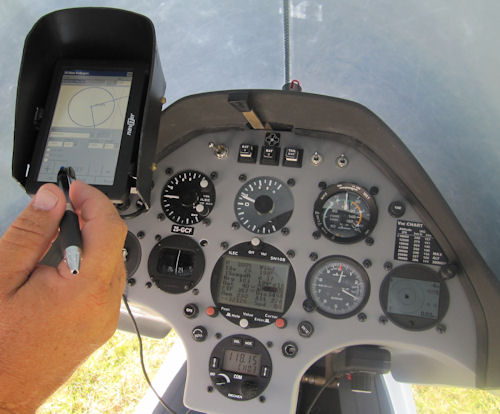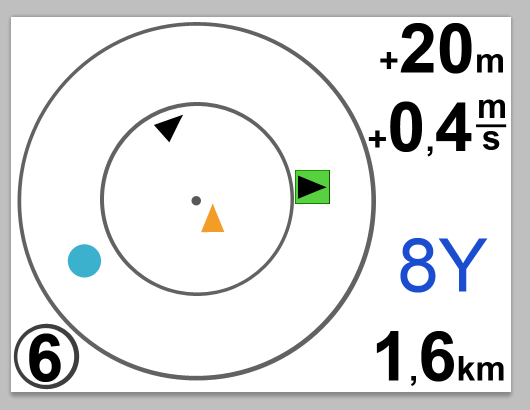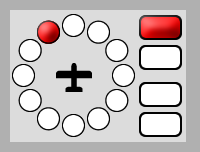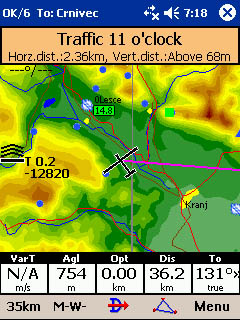
Bill Elliott
Planning the panel for my new JS1 took quite a while as I wanted to make sure that I was going to take advantage of the latest technology. Key to me was investigating the new Flarm Technology improved situational awareness and collision avoidance. I also needed to add something to handle the European airspace issues. After much investigating, I added the Flarm system and switched to SeeYou mobile.
 I setup my JS1 for the WGC in Hungary with a classic Flarm. The Flarm provided the following:
I setup my JS1 for the WGC in Hungary with a classic Flarm. The Flarm provided the following:
- GPS data for the SN-10 Flight Computer
- IGC-approved flight record for my flights
- Collision-avvoidance warnings
- Through the Panel mounted Butterfly Display
- Through SeeYou Mobile and the PNA
- Through the SN-10 (although turned off)
- Situational Awareness of Other Flarm-equipped aircraft
The Flarm sent GPS and Flarm traffic/collision information to my SN-10. The SN-10 then supplied the GPS and Flarm data to my my Oudie and SeeYou mobile. So I had multiple instruments processing the Flarm information and providing me different information on different displays which were useful for different times during flight. You can see more details of my installation here.
In addtion, there is a nice panel mounted display since the Flarm was mounted behind my panel. I found the Flarm to be absolutely invaluable. Not only did it do a great job of alerting me to potential collision, the Flarm provided an amazing amount of situational information about glider around your that were not on a collision path -- just simply not in your immediate field-of-view; say, someone at your 6 o'clock in a thermal or on course.
Flying in my first WGC was quite an experience. We often had poor weather which would push us into very large start gate gaggles of 30 or more gliders. Then, on course, it was not unusual to be in gaggles of 15-20 gliders! I was very impressed with the Flarm's ability to provide good collision avoidance warnings without too many false alarms. With the  Butterfly Display, a radar-like presentation of traffic is displayed. The image to the left gives and example. My glider is situatued in the center of the display. Other gliders are shown as black triangles in positions on the radar relative to my nose and the triangle pointing in the direction each glider is currently heading. I have a rotary knob that I can rotate and switch from glider to glider with the current glider highlighted in green on the display and the specific information about the highlighted glider shows up on the right side of the display. In the example, 8Y is highlighted and is 20m higher then me and going up at 0.4 m/s. 8Y is also about 1.6km away. Clearly, I did not "twiddle" this dial or focus very much on this display while I was thermaling!
Butterfly Display, a radar-like presentation of traffic is displayed. The image to the left gives and example. My glider is situatued in the center of the display. Other gliders are shown as black triangles in positions on the radar relative to my nose and the triangle pointing in the direction each glider is currently heading. I have a rotary knob that I can rotate and switch from glider to glider with the current glider highlighted in green on the display and the specific information about the highlighted glider shows up on the right side of the display. In the example, 8Y is highlighted and is 20m higher then me and going up at 0.4 m/s. 8Y is also about 1.6km away. Clearly, I did not "twiddle" this dial or focus very much on this display while I was thermaling!

If the Flarm calculated a potential collision hazard, audible warnings began sounding and the Butterfly Display changed to a very easily readable screen indicating both the direction of the threat and weather it was above or below. You can see more about the screens that the Butterfly Display shows here.
The gaggles were quite intense with traffic everywhere, people shifting in the thermals, and even sometimes overlapping cores! It was absolutely critical to keep your eyes out of  the cockpit! This is where SeeYou Mobile and the Oudie played an important role. The Oudie has a voice module which provide an intelligent, understandable alert as to the direction and distance to the threat. The screen shown to the left illustrates the banner that is displayed across the top of the PNA (or PDA). It is quite visible! However, the Oudie also announces after a brief attention getting alarm,
the cockpit! This is where SeeYou Mobile and the Oudie played an important role. The Oudie has a voice module which provide an intelligent, understandable alert as to the direction and distance to the threat. The screen shown to the left illustrates the banner that is displayed across the top of the PNA (or PDA). It is quite visible! However, the Oudie also announces after a brief attention getting alarm,
"Traffic 11 O'clock ... Distance 2.3 Km ... 68m Above".
Again, I am able to keep eyes out of the cockpit and quickly pickup any traffic that I may have not seen.
There were so many cases where the Flarm alerted my to traffic. Not always (and probably not usually) a case that I had not seen; however, it is hard to know what alerted my first.
Usually, the Flarm would be quiet. If I was alone with no other Flarm-equipped aircraft in range, then the Butterfly Display simply showed GPS and VHF Send Status. When a the Flarm detected a glider, a small "beep" was sounded and the radar screen came to life showing where this glider was relative to me. It was hard not to know someone was close by.
On the Limits of Operatio, Flight Situations page, there is a chart that suggests Flarm is least capable while thermalling. I did not find that to be necessarily true. In well established gaggles with gliders positioned nicely, the Flarm rarely set off alarms. However, when gliders started jostling for position and someone would get close or cut in front of you, the Flarm would get quite vocal about it--I didn't mind these alarms at all. It was also easy to keep up with other aircraft in the gaggle with the radar display and with SeeYou Mobile zoomed in to show the gaggle displaying the other aircraft. You always new if someone else was behind you or outside of you where you could not see.


